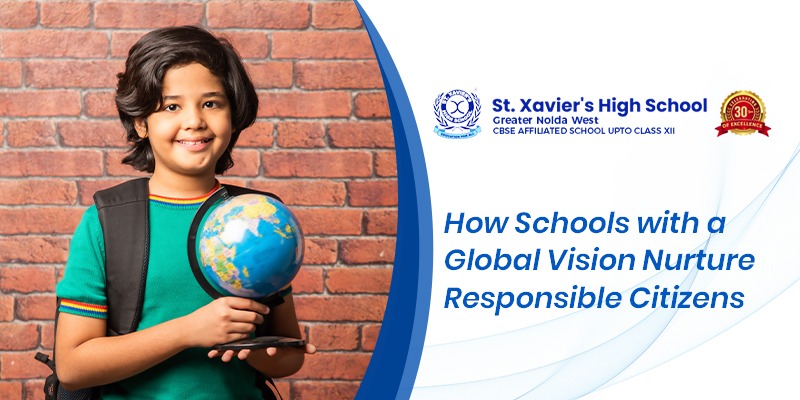Introduction:
In today’s interconnected world, education is no longer confined to the four walls of a classroom. At St. Xavier’s High School, one of the top schools in Greater Noida West, the most successful learning environments help students see beyond borders, embrace cultural diversity, and take responsibility for creating a better world. Schools that follow a global vision are not just producing high achievers—they are shaping responsible global citizens who understand empathy, ethics, and the power of collaboration.
These institutions have redefined education by integrating global perspectives into all aspects of learning. They nurture intellectual excellence while instilling values that prepare students to thrive in an interconnected society (UNESCO Global Citizenship Education).
About Us:
We are dedicated to setting a new benchmark where quality education goes hand in hand with student wellbeing. Academics are reinforced by mindful learning, physical wellness, and emotional resilience. Our calendar features wellness weeks, mindfulness sessions, health fairs, cultural celebrations, and sports extravaganzas, ensuring a holistic growth environment. Extracurricular programmes in music, dance, yoga, football, tennis, and creative arts provide outlets for energy and expression. Regular student-mentorship meetups, wellbeing check-ins, and peer-support clubs further reinforce a culture of care. Our yearly “Healthy Minds & Happy Hearts” carnival and “All-Round Excellence” awards evening highlight how each child is valued in their entirety—mind, body, and spirit.
Features of a Global Vision in Education
1. The New Definition of Global Vision in Education
A global vision prepares students to engage meaningfully with the world by appreciating diversity, thinking critically about international issues, and acting responsibly locally and globally. Success in the 21st century requires emotional intelligence, cross-cultural competence, and global awareness.
2. Building Responsible Citizens from the Ground Up
Through community service programs and environmental projects, students learn the value of giving back and develop compassion and integrity. These lessons build a foundation for lifelong responsible citizenship.
3. Integrating Global Perspectives into Everyday Learning
Subjects such as history, geography, and science include global case studies and contemporary issues like climate change and equality. Model UNs and collaborative projects help students understand global interconnections (Global Education Monitoring Report).
4. Encouraging Cross-Cultural Understanding
Interaction with peers from diverse backgrounds fosters mutual respect. International exchange programs and cultural festivals celebrate diversity as a strength.
5. Character Education and Ethical Awareness
Moral development is emphasized alongside academics with programs in honesty, respect, compassion, and accountability.
6. Environmental Awareness and Sustainable Living
Participation in eco-clubs and sustainability initiatives teach the importance of protecting our planet—a crucial trait for future leaders.
7. Leadership Through Empathy and Service
Students engage in service-learning, student councils, and charity events that cultivate collaboration and integrity.
8. Technology as a Gateway to Global Learning
Digital tools and international collaborations enable global connections and digital fluency, preparing students for modern learning environments (EdTech Review).
9. Nurturing Emotional Intelligence and Wellbeing
Mindfulness programs and wellness workshops strengthen emotional resilience, fostering balanced, socially aware individuals.
10. Developing Communication and Collaboration Skills
Debates, team projects, and international partnerships help students communicate effectively and embrace diverse viewpoints.
11. Community Engagement and Local Responsibility
Local outreach programs connect global awareness with immediate action, promoting social responsibility.
12. Promoting Innovation and Problem-Solving
Robotics labs and entrepreneurship challenges nurture creativity and critical thinking—essential skills for changemakers.
13. Teachers as Mentors of Global Growth
Educators mentor students through global perspectives and ethical decision-making, fostering curiosity and respect.
14. Encouraging International Collaboration and Exchange
Student exchanges and internships broaden perspectives and cultural adaptability.
15. The Future of Global Education: From Learning to Action
Schools inspire students to be global changemakers through advocacy, projects, and leadership roles.
Conclusion:
Academic knowledge alone is no longer enough. The leaders of tomorrow must be empathetic, ethical, and globally aware. At St. Xavier’s High School, among the top schools in Greater Noida West, education balances intellect with integrity. These institutions create responsible global citizens prepared to make a positive impact on the world.
FAQs
Q1. What does it mean for a school to have a global vision?
A school with a global vision prepares learners to think beyond borders, fostering cultural awareness, sustainability values, and empathy through globally connected learning experiences.
Q2. How do globally focused schools encourage responsible citizenship?
They integrate social responsibility projects, eco-awareness programs, and global issue discussions into the curriculum to develop socially responsible students.
Q3. Why are international collaborations important in education?
They expose students to diverse perspectives and innovative ideas, enhancing cross-cultural communication and problem-solving skills.
Q4. What skills do students develop in globally aligned classrooms?
Adaptability, leadership, ethical awareness, and a sense of global community to thrive in diverse environments.
Q5. How can teachers help students become socially aware leaders?
By organizing debates, model UNs, and service-learning projects that inspire responsibility and ethical engagement.
Q6. What role do parents play in shaping globally minded students?
Parents reinforce curiosity about global events, promote diversity at home, and encourage community participation.

